by Carole Dazzi e Romina Ciulli
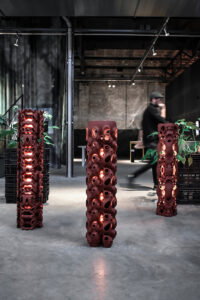
The sculptures-objects by Rollo Bryant, a Dutch designer, incorporate the immediacy of freehand work with digital simulation, and are the result of a research that focuses in particular on the integration between the functionality and aesthetics of the object, organic and natural structures. In fact, Bryant’s works pay particular attention to the innovation of materials, the composition of the texture and the lighting. His path is directed towards a change of the idea of production, in order to create a realization method that is conceived, and then perceived, as responsible. It is therefore a practice sensitive to environmental problems, aimed at safeguarding biodiversity and the requalification of the urban environment as a shelter for the various living species. The spaces are designed for humans and reinterpret the relationship between artificial and natural environment, creating new habitats based on synergy and interspecies coexistence. Rollo Bryant is part of that new generation of designers who intend to moderate the impact of man on the cities of the future and minimize the negative effects on biodiversity, to preserve and respect the integrity of the environment around us. Let’s talk with him.
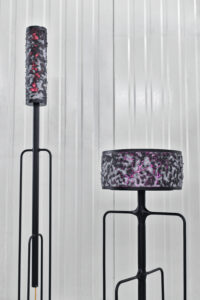
In your projects, you combine the tradition of manual work with the expressive possibilities of new digital technologies. How do you develop your works? And what is your relationship with technology in creating a visually new object?
The incredible possibilities of new digital tools through various different open source softwares have opened up a huge opportunity for young designers such as myself in allowing a new kind of freedom in experimentation. My process is simply to search for different modelling techniques that I can piece together into a kind of system that allows for a wide variety of possible outcomes. Although many people have made the assumption that I am using computational design, in fact I am actually modelling mostly through freehand sculpting tools with the help of particle/fluid simulations to smooth out the results and tidy up the geometry. The production side of my process, using 3d printing has of course opened up the freedom to be very playful and prototype designs that would otherwise be near impossible to interact with physically.
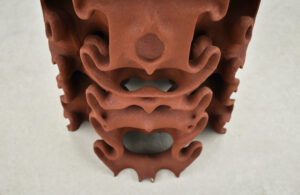
In one of your most representative projects, Urban Stem, you created a lighting system that pursues to integrate with the surrounding environment, almost as if it grew directly from the ground. In this way it manages to simultaneously perform its primary function as a source of light, but also act as a refuge and nest for plant and animal organisms. To what extent is design also a means to raise awareness of society towards current problems on the environment and biodiversity? Can you tell us about it?
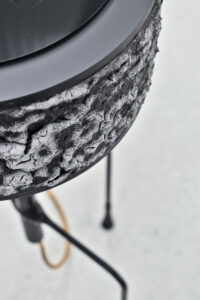
I think that at this moment, the moment behind the raising awareness not just for the problems surrounding our environmental challenges, but actually to inspire solutions is very important for any designer. The project really started by looking at these urban green public spaces and seeing the clear division between grass and tarmac.. I thought it was interesting to consider the idea that our infrastructure in these spaces could not only be to the benefit of people, but could also serve many different kinds of wildlife. For me, the aim was not to design for a particular ecosystem, but as you mention, to share an idea that designing in this way for the public domain can open up many more possibilities that are more site specific.
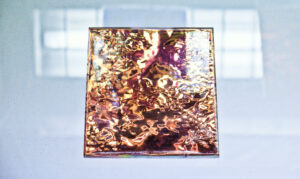
In the realization of your projects, a key aspect is that of the research on materials, textures and colors, which have the particularity of recreating the constitutive qualities of natural elements. In Urban Stem, for example, you were inspired by the Tafoni rocks, characterized by the alternation of solids and voids caused by the progressive erosion. In the Synergy Salt Lamps, on the other hand, the texture is shaped by the formation and crystallization of the salt which, favored by bioplastic, creates an irregular and material surface through which the light filters discontinuously to conceal its true function. And in Lattice, you developed a new material made of tiles with particular shades of color and texture, inspired by the mantle of the chameleon, which are reactive to the environment in which they are inserted, and change according to the way they are illuminated or if the perspective is altered. Thus the natural element is the primary source of inspiration for your work, becoming the expression of a changing and constantly moving nature. Where does this fascination come from?
I think that biomimicry is hugely exciting and there is so much to learn and be fascinated with when it comes to natural processes or material changes. For me in the projects you mention, it has always been the case of looking into a very specific thing that I find either beautiful or interesting, and seeing how I can use new methods or technology to explore different way’s of utilizing these qualities within my designs.
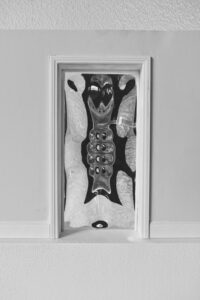
Instead Bobulate is a playful project. In fact, it consists of a door on which is inserted a lens with convex and concave parts that reflects the figure of the observer enlarged or reduced depending on where it is located, thus returning a fluid and constantly changing portrait. This optical door deviates from its practical use of allowing entrance and exit, to create on the contrary a changing interspace between two different zones, and alter the perception that the individual has both of himself and of the space he is about to enter. Why in this case does design become a means to change the perception not only of an environment, but also of the individual towards himself?
To be honest, I wasn’t thinking on such a deep level about the perception of the individual towards himself, I was indeed trying to give what might be considered a mundane object a more playful element that would be fun to interact with. The idea was to play with this boundary between spaces by showing a constantly shifting state of mood. movement, light and texture, are communicated, but in an abstract way. Just as a window to the outside is a window to the world, I found it interesting to give this window to a different level of communication in which only a fragment of the observed can be identified.
Who are the artists/designers that inspired your artistic path or are you currently inspired by?
One of my biggest inspirations is a dutch designer called Joris Laarman, I find his work both incredibly beautiful and technically astonishing. The diversity in his work, from furniture to bridges, keeps his process fresh and progressive.
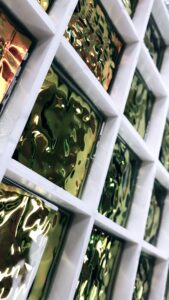
Can you tell us about your future projects?
Currently I am developing my new collection that will hopefully bring about new questions about designing for humans in respect to nature. The designs are more minimal in overall form language but much more detailed internally. I have been developing a new modelling technique that uses tessellation’s across the geometry allowing for much more control over how the light is diffused through the lattice structures. I’ve also started a collaboration with a German company who are using particle bed printing, which in turn will allow me to model designs with far fewer limitations as I will not have to concern myself with removable support structures. In general this new collection will serve as a continuation of my previous work for Urban Stem, but will hopefully show how I’ve learnt and refined my methodology in its visual outcome.
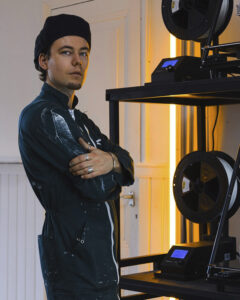
Biography: Graduated in Design at the Eindhoven Academy of Design, Rollo Bryant focuses his attention on design as a means of environmental change, using working techniques that combine freehand sculpture with computational software. His works have been exhibited at important international events, such as the Milan Design Week and the Venice Biennale.